The annual Wine, Beer & Spirits Law Conference will be held on September 22-23, 2016 in Colorado Springs, CO to discuss the latest developments in alcohol policy and practice. Co-Chair and McDermott partner Marc Sorini has again lined up a great program of speakers on legal topics of interest to the industry. In addition, Marc and McDermott Partner Andrew B. Kratenstein will give the following presentations:
- Thursday, September 22, 9:30-10:15 am: Marc will help kick off the conference by discussing the intersection of the First Amendment and tied-house law.
- Thursday, September 22, 3:15-4:30 pm: Andrew will join three other lawyers to explore the strategies and tactics of supplier-distributor disputes, touching on venue, injunctions and other topics.
For more information or to register, please visit https://www.cle.com/Broadmoor.
read more


 Subscribe
Subscribe

